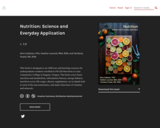
This book is designed as an OER text and learning resource for undergraduate students enrolled in FN 225 Nutrition at Lane Community College in Eugene, Oregon. The book covers basic nutrition and metabolism, information literacy, energy balance, nutrition across life stages, dietary supplements, an in-depth look at each of the macronutrients, and major functions of vitamins and minerals
COURSE DESCRIPTION: Nutrition is a study of how the body takes in and uses the nutrients from food. Food sources, functions, and requirements of the following are discussed: carbohydrates, proteins, fats, vitamins, minerals and water. In addition, digestion, absorption and metabolism of all nutrients are covered. Skills are developed for improving personal eating habits and for evaluating nutrition information in the mass media.
Student Learning Outcomes: Upon successful completion of this course, students will be able to:
1. Define and classify the six classes of nutrients.
2. Identify where the six classes of nutrients are found in foods.
3. Explain how the six classes of nutrients are digested, absorbed, metabolized, and utilized.
4. Distinguish between adequate nutrient intake, deficiencies, and toxicities and how these levels impact body systems and health outcomes.
5. Acknowledge the importance of a moderate approach when it comes to nutrition and weight management, recognizing all foods can fit into a healthful diet.
6. Recognize that nutrition and its effect on our physical body is only one dimension of health and others are equally important, including exercise, sleep, finding purpose, freedom from excessive stress and community relationships.
7. Apply scientific reasoning to evaluate the evidence base and validity of nutrition information in the media.
8. Record and evaluate personal dietary intake using the Recommended Dietary Allowances, Dietary Guidelines, and various food guides and identify behavior change strategies for improvement if necessary.
9. Critically evaluate and compare nutrition labels and determine the nutrient density of each food.
10. Summarize factors that facilitate or constrain lifestyle choices that impact health outcomes.
11. Identify guidelines and recommendations for choosing nutrition supplements and appropriate use.
12. Describe how diet, prior training, duration and intensity of activity impact fuel use before, during, and after exercise.
- Subject:
- Health and Physical Education
- Material Type:
- Textbook
- Provider:
- OpenOregon
- Author:
- Alice Callahan
- Heather Leonard
- Tamberly Powell
- Date Added:
- 06/16/2021